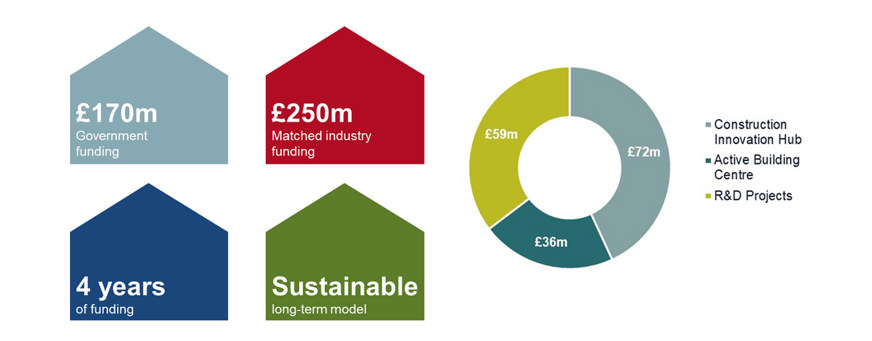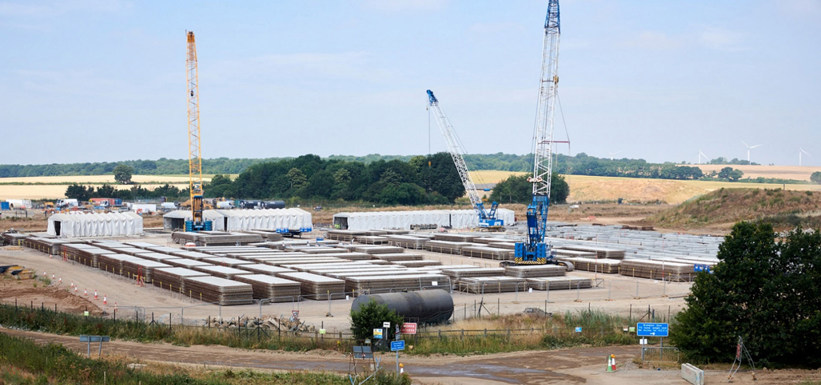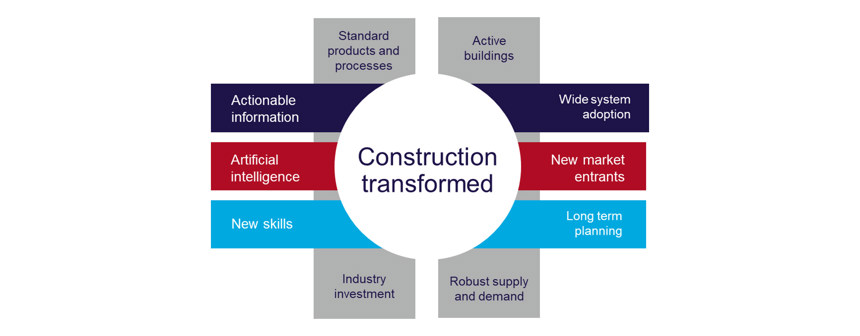Bridge Programme
Platform ProgrammeThe establishment of the Construction Innovation Hub is a pivotal event for UK construction. The Hub is at the centre of the £170m Transforming Construction programme, which will create better value, speed and sustainability in the built environment.
Construction is the last great unreformed industry, yet vital for all our lives. It employs nearly 10% of the global population. Main contractors and many of their suppliers experience negligible profit margins. Buildings often use more energy than they are designed to do, and indeed are designed to use more energy than the planet can sustain. The greenhouse gas emissions from the built environment represent about a third of the world’s total emissions.
In July 2018, the Government published the Construction Sector Deal as part of the Industrial Strategy. The Sector Deal describes how Government procurement will leverage change in the design and assembly of buildings, how the skills challenges faced by the industry will be addressed, and how £170m provided as part of the Industrial Strategy Challenge Fund (ISCF) will bring to market the solutions needed for transforming construction. I am proud to be leading the allocation of the £170m ISCF contribution, plus the £250m pledged by industry – a total of £420m to be invested over four years.

Picture: Funding of the UK Construction Sector Deal
For those of us who have spent years on construction sites, the problem of waste is all too familiar. Defects emerge during the construction process in the form of rework and at handover in the form of snags. Defects alone can eat up a significant proportion of project cost. In asset operation defects manifest as lack of durability and performance gaps, particularly in energy usage. Waste in terms of over-production exists as endless re-design of building elements. Structural frames, for example, could be standardised.
Vast amounts of time is wasted on construction projects waiting for deliveries to arrive on site, for labour to arrive, or for sign-off of work before subsequent stages can begin. Much has been said about the growing problem of construction labour shortages – but there is just as much wasted, or non-utilised, talent. Waste might be driven by inefficient processes, or due to use of people for simple tasks that could be automated, and some is due to lack of appropriate training.
The single biggest proportion of delivery to construction sites is surplus material that ends up being thrown away. Materials brought from unnecessarily distant locations, double handing of goods and plant movements on site are excessive. Construction is carried out in ways that require excess people movements – people travelling long distances to the site, or just moving too much during the course of their day at work. The just-in-time concept used in manufacturing is rarely applied in construction due to programme and design uncertainties. Finally, there is over-processing waste such as unsuccessful tendering, duplication of tasks and unnecessary checks.
If we can find ways to address all this waste, we will hit the value, time, emissions and export targets of the TC programme. We would be able to increase output by a third, at better quality, with lower emissions.

Picture: Waste in construction vs manufacturing
Addressing waste is central to Lean Six Sigma (LSS) methodology. LSS is a managerial concept combining Lean and Six Sigma. The former originated at Toyota in Japan and the latter at Motorola in the US, both in the 1980s. Lean focusses on efficiency, Six Sigma on defect elimination. LSS has been transformational in other industries, but has had limited impact on construction. I believe that to realise the potential of Lean Six Sigma in construction, we have to start by considering it at an industry level.
LSS focusses not just on doing things right, but doing the right things right. It starts with attention to the measurable requirements of the customer. What are the requirements of the Government departments orchestrating the construction needs of society: Education, Health, Defence, Justice, Housing and Transport? LSS addresses the management, improvement and smoothing the flow of processes. Data systems enable manage by fact. People are trained and equipped for the optimised processes. All this is done within a framework of continuous improvement known as DMAIC – define, measure, analyse, improve, control.

Picture: Industrialising construction at Skanska’s A14 ‘Flying Factory’
The Construction Innovation Hub is getting the construction industry ready for the implementation of Lean Six Sigma, with its own application of DMAIC. It will enable the designers, manufacturers and assemblers to coordinate their efforts to deliver value to society efficiently and with minimal defects. At the heart of this lies the platform approach to buildings.
One of the key inputs is knowledge of the procurement pipeline. Another is assessment of the existing product design portfolios of social and economic infrastructure. This will form one of the inputs to the platform design portfolio.
Measurement systems will collect and share information about assets and organisations. Analytical tools are being developed and applied. For example, a tool to weigh up different aspects of whole life value in order to guide procurement.
Many improvement activities are already underway. The ‘Seismic’ project has defined standardised steel frames for schools. This involves a partnership of offsite suppliers, consultants, and designers working in collaboration with the Hub. The Seismic frame has already been used as the basis for a house design competition run in collaboration with George Clarke’s Ministry of Building Innovation and Education (MOBIE), with a pilot house under construction. The Hub’s Platform Design Call will expand the portfolio to coordinate the efforts of many suppliers across components and building types. Clients will be able to use a set of configurator tools to choose their buildings, and companies will be able to contribute their components.
The Hub will pilot improvements in production efficiency using standardised processes and automation. This, along with information about the demand pipeline, will give businesses confidence to invest in their own process automation. The Hub will support improvement by producing a set of job profiles reflecting both the platform and process automation approach to construction. The Hub and the wider TC team will be continuously tracking and controlling the outputs of the programme.
The Hub will tie together all components of the £170m TC programme, which includes £36m for the Active Building Centre (ABC), £57m for research and demonstration and £2m for the Network Plus (N+). The Active Building Centre is working on the widespread deployment of buildings that function as power stations: generating, storing and distributing more energy than they consume. This has been proven economically feasible for schools, offices and homes through the work sponsored by the Welsh Government in Swansea. The new buildings will not only eliminate their impact on global warming, but also reduce transport emissions by powering electric vehicles.
Already, £18m has been allocated to develop and de-risk innovative solutions for construction. These include applications of artificial intelligence, digital techniques for construction and smart assets, and factory-based construction. A further £10m will be allocated to development of construction solutions, and £26m to demonstration of techniques on live construction projects. Funding calls open in August 2019.
The Network Plus unites construction’s academic and industrial communities to create a research and knowledge base dedicated to addressing the systemic problems holding back the sector. Work being sponsored includes benchmarking, user experience, technology transfer and interoperability studies. Further work will be commissioned before the end of 2019.
These major changes will support transformation of the construction eco-system. The industry will become more vertically integrated, using standard products and processes to create buildings. Where possible buildings will include active (energy positive) technology. Some companies will evolve to span the value chain, in other cases projects will take an enterprise approach, with agreed common success factors for participants. The collection and sharing of information will also enable the industry to integrate horizontally. This shared information will enable construction to mobilise the potential of machine learning (artificial intelligence) to improve decision-making.

Picture: Integrating the construction industry
For a long time construction has looked enviously at the performance achieved in other industries. With this transformation programme, we are applying the system changes that not will not only achieve a great set of outcomes for the UK, but also demonstrate how to deliver similar benefits across the world.
Sam Stacey is the Challenge Director – Transforming Construction at Innovate UK.